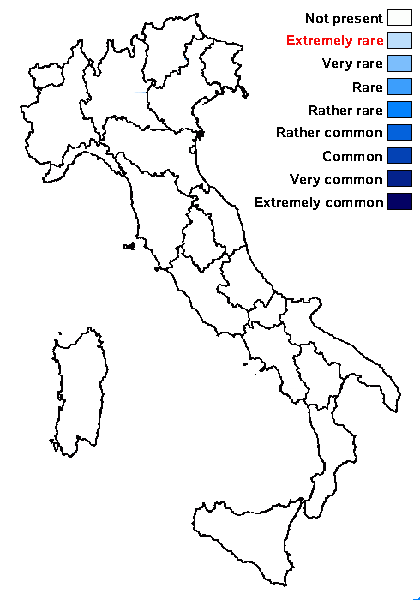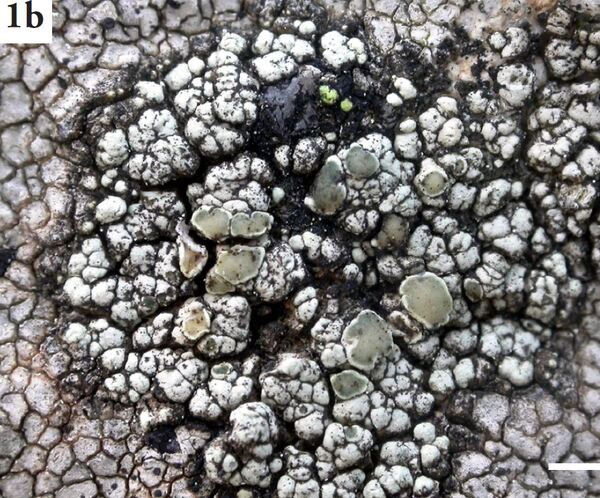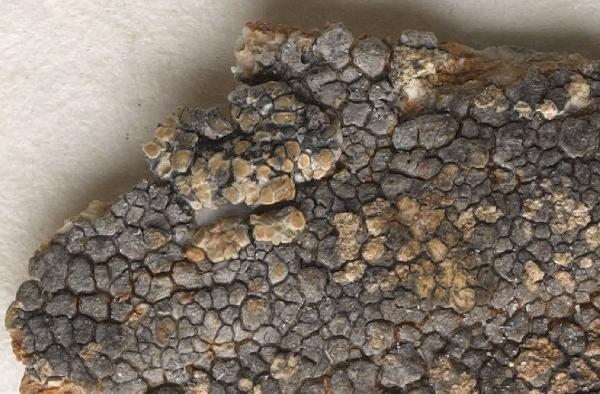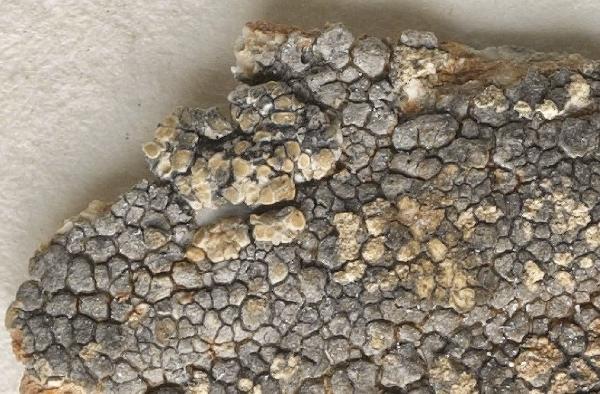Lecanora tolypodes Poelt & Vězda
in Poelt, Mitt. bot. Staatss., München, 8: 199, 1970
Synonyms:
Distribution:
Description: Thallus crustose, episubstratic, granulose to granulose-areolate, almost glossy, greenish white to yellowish green, forming 0.5-2 cm wide, more or less orbicular, sometimes confluent islands on the thalli of a sorediate species of the Aspicilia cinerea-complex, the areoles/granules at first strongly convex, then almost umbilicate, strongly constricted at base, (0.2-)0.5-2(-3.5) mm wide, 0.25-1.9 mm thick, round to irregularly angulose, the marginal ones indistinctly lobulate, the lower surface whitish to bluish- or brown-black; prothallus absent but a greenish black hypothallus is sometimes visible below the areoles. Cortex colourless, 35-60 μm thick, with a 5-17 μm thick epinecral layer containing numerous crystals insoluble in N and soluble in K, and a 20-40 μm thick paraplectenchymatous layer filled with crystals; algal layer continuous; medulla 125-650 μm thick, arachnoid, with both large and small crystals soluble in N and insoluble in K. Apothecia lecanorine, numerous and crowded, (0.2-)0.4-1(1.5) mm across, adnate to sessile and constricted at base, the largest ones irregular in outline, with a mostly flat, greenish to pale ochraceous yellow disc and a hardly raised, smooth, finally sometimes almost excluded thalline margin. Thalline exciple 80-130 μm thick, thicker at base, corticate, the cortex with crystals, rich in algae; proper exciple colourless, 30-55 μm thick, thicker in upper part, paraplectenchymatous; epithecium yellowish brown, with a few green dots (a few paraphyses with the Cinereorufa-green pigment), 15-22 μm high, with small granules and yellowish bacilliform crystals soluble in K and insoluble in N; hymenium colourless 40-55 μm high, I+ blue; paraphyses coherent, simple or sparingly branched and anastomosing, 1.5-2(-2.5) μm thick at base, the apical cells 2.5-4 μm wide; subhymenium colourless, 35-50 μm high, without crystals; hypothecium colourless, 20-130 μm high, rich in clustered crystals soluble in N but not in K, I-. Asci 8-spored, broadly clavate, Lecanora-type. Ascospores 1-celled, hyaline, ellipsoid to broadly ellipsoid, (7.5-)8-12(-12.5) x (5-)5.5-6.5(-7) μm, thin-walled. Pycnidia rare. Conidia thread-like, curved or sigmoid, 11-19 x 0.5-1 μm. Photobiont chlorococcoid. Spot tests: K-, C-, KC+ yellow, P-. Chemistry: usnic acid, zeorin (major), rangiformic acid and two unidentified substances (minor).Note: a species of the L. polytropa-group growing as a parasite on Aspicilia-species, developing minute fertile thalli on steep faces of siliceous rocks; so far only known from the alpine belt in Switzerland; to be looked for in the Italian Alps. The description is based on Roux & al. (2022).
Growth form: Crustose
Substrata: rocks
Photobiont: green algae other than Trentepohlia
Reproductive strategy: mainly sexual
paras Aspicilia sp.

Predictive model

Source: Roux C., Bertrand M., Poumarat S., Uriac P. 2022. Quelques espèces nouvelles saxicoles – calcifuges de Lecanora du groupe polytropa (Ascomycota, Lecanoraceae) découvertes en France. Bull. Soc. linn. Provence, 73: 79-120.

Detail from: https://gzu.jacq.org/GZU000290746
GZU000290746 - J. Poelt Date 1967-08-05
Location Switzerland / Graubünden
Label Silvretta-Gruppe, Geschützte Steilfläche eines großen Blockes am Wege von der Heidelberger Hütte, Val Fenga, zum Fimbergletscher ; Alt. 2400 m
Habitat Geschützte Steilfläche eines großen Blockes

Detail from: https://gzu.jacq.org/GZU000290746
GZU000290746 - J. Poelt Date 1967-08-05Location Switzerland / GraubündenLabel Silvretta-Gruppe, Geschützte Steilfläche eines großen Blockes am Wege von der Heidelberger Hütte, Val Fenga, zum Fimbergletscher ; Alt. 2400 mHabitat Geschützte Steilfläche eines großen Blockes
Growth form: Crustose
Substrata: rocks
Photobiont: green algae other than Trentepohlia
Reproductive strategy: mainly sexual
paras Aspicilia sp.

Predictive model

Source: Roux C., Bertrand M., Poumarat S., Uriac P. 2022. Quelques espèces nouvelles saxicoles – calcifuges de Lecanora du groupe polytropa (Ascomycota, Lecanoraceae) découvertes en France. Bull. Soc. linn. Provence, 73: 79-120.

Detail from: https://gzu.jacq.org/GZU000290746
GZU000290746 - J. Poelt Date 1967-08-05 Location Switzerland / Graubünden Label Silvretta-Gruppe, Geschützte Steilfläche eines großen Blockes am Wege von der Heidelberger Hütte, Val Fenga, zum Fimbergletscher ; Alt. 2400 m Habitat Geschützte Steilfläche eines großen Blockes

 INDEX FUNGORUM
INDEX FUNGORUM
 GBIF
GBIF

